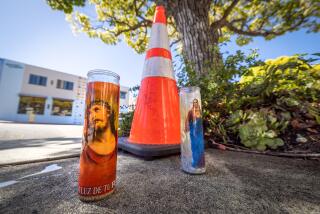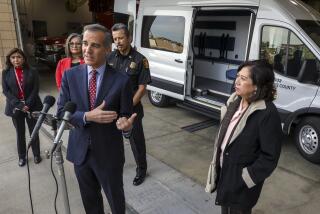Delayed 911 response a matter of geography and jurisdictions
Stephanie Hooks pleaded for help after collapsing on the floor of her South Los Angeles home.
“I can’t breathe.... Help me breathe!” the 53-year-old grandmother wailed as frantic family members took turns on the phone with a Los Angeles Fire Department dispatcher, who alerted paramedics at a city station nearly 3 miles away.
More than a mile closer, just across the city border, rescuers at a Los Angeles County Fire Department station sat idle, unaware of the unfolding emergency, county records show.
It took more than 10 minutes for LAFD paramedics to reach Hooks, who went into cardiac arrest and died at a hospital. A faster response might not have saved her, but the February 2009 incident highlights a failure to fix how the agency responds to thousands of emergency medical calls along L.A.’s jagged borders despite reforms promised decades ago.
Los Angeles’ city and county fire agencies agreed in 1979 to link their dispatching operations to save lives and cut costs. But a Times analysis of more than 1 million LAFD responses over the last five years shows the agency rarely reaches across jurisdictional lines for county help. One result: 911 callers within a quarter mile of the city border are nearly 50% more likely to wait more than 10 minutes for rescue crews to arrive.
According to national standards embraced by the LAFD, firefighters are supposed to arrive in under six minutes to almost all medical emergencies.
In more than 70,000 medical calls, LAFD sent rescuers to locations where county firehouses were closer, the analysis found. More than 1,300 of those cases were cardiac arrests, where delays of seconds can be critical because irreversible brain damage can begin just four minutes after the heart stops beating.
Fire Commissioner Alan Skobin, who is leading a review of problems with the department’s response times, expressed concern about the Times’ findings. He said the commission would examine whether the LAFD’s dispatch system could be tied into the county’s fire rescue network.
“If there’s a way to leverage technology to get another unit to the scene, we should be doing that,” Skobin said.
For years, other fire agencies across the nation have been pooling resources and using technology to create “automatic aid” dispatching systems that send the nearest emergency units, regardless of jurisdiction. “A political boundary should never put someone’s life in jeopardy,” said Timothy E. Sendelbach, who has written about the issue as the editor of FireRescue Magazine. Some of California’s largest fire agencies — including those serving the Orange County, San Diego and San Jose areas — have already adopted cross-border dispatching.
Tight city budgets in San Diego County helped persuade fire officials at eight agencies to adopt automatic aid agreements, said Maurice Luque, spokesman for the San Diego Fire-Rescue Department. “Basically, there’s no borders anymore,” he said. Officials with the Orange County Fire Authority say their department is part of a “seamless” 911 response network with 10 fire agencies.
That was the goal set in Los Angeles a generation ago.
In 1979, then-LAFD Chief John C. Gerard wrote to the Fire Commission and said that enlisting county assistance near the city border “would improve emergency response times” and “produce significant saving in lives and property.”
The departments later signed a formal automatic-aid agreement that called for electronically linking dispatch systems, records show. But the connection was never made, partly because of costs, said county Battalion Chief Jon O’Brien. “It’s being mapped out,” he said, “but it’s nothing that’s going to get handled in the short term.”
Los Angeles Fire Chief Brian Cummings said he wasn’t familiar with the agreement and could not comment on it.
Cummings acknowledged that county firehouses are closer than city stations in some areas of Los Angeles. But he said it was the LAFD’s responsibility to send the appropriate unit to every emergency within city boundaries. “We do it very well 1,100 times a day,” he said.
Currently, if city dispatchers want to summon county units they must use telephones, a process that takes too long, Skobin said. Over the last five years, when county fire stations were closer, LAFD dispatchers called county rescuers in less than 10% of emergency medical cases, according to the Times analysis, which included both agencies’ dispatch records.
Dwayne Anderson’s home in Hyde Park in South Los Angeles is half a block from the border and less than a mile from a county firehouse with paramedics.
Shortly before sunrise one day last March, Anderson realized that his 59-year-old girlfriend, Elaine McKinney, who had been battling breast cancer, was unconscious. She had suffered cardiac arrest, LAFD records show.
Anderson called 911 using a cellphone and was mistakenly connected to a county operator, who transferred him to the LAFD because he lived in the city.
Nervous and scared, Anderson began CPR under the guidance of the dispatcher as he waited for firefighters to arrive. He assumed rescuers would come from the nearest firehouse — the county station, where records show paramedics were available. “All I wanted was help,” he said.
Instead, LAFD units — two fire trucks with no paramedics — were being dispatched from a station nearly 3 miles away, records show.
They reached Anderson more than 11 minutes after LAFD dispatchers answered his call. It took nearly 2 more minutes for a paramedic ambulance to arrive, records show.
McKinney died at a nearby hospital, according to the county’s office of vital records. Anderson wonders whether her chances would have been better if the closest rescuers had responded. “For people who have life-and-death problems, it shouldn’t matter where you live,” he said.
Other neighborhoods with longer-than-average response times include those bordering West Hollywood, East Los Angeles and a strip of the city less than a mile wide that stretches from South L.A. to the harbor, the analysis found. Nearly 30 years ago, the city strip was labeled a “Valley of Death” by a top county medical official after a nurse suffered a fatal heart attack there — and was left waiting for distant city rescuers when county fire units were closer.
In South L.A., part of the Gramercy Park neighborhood is surrounded on three sides by county territory. That’s where Stephanie Hooks lived for more than 10 years.
A former quality-control analyst at a microchip firm, Hooks enjoyed caring for her 7-year-old granddaughter and watching her teenage daughter, Alnisha, compete in track and field events.
Early one morning, Hooks began gasping for air as she left home to walk her dogs.
“Call 911!” her husband yelled.
Family members took turns talking to the LAFD dispatcher on speaker phone, according to a copy of the 911 tape obtained by The Times.
“Stay calm ‘cause the firemen are on the way,” the dispatcher said early on in the call.
After four minutes, help still had not arrived.
“They’re not here!” Stephanie Hooks shouted. “I can’t breathe!”
“Mommy, you’re scaring me,” Alnisha told her.
“I know there’s a fire station on 108th,” Alnisha said five minutes into the call, referring to the closer county firehouse where medics were available.
“Where they at?” demanded Hooks’ agitated husband, Alvin. More than a minute later, he asked again.
“They’re just a little ways away,” the dispatcher assured him. “You’ll be hearing sirens shortly.”
But the agonizing wait continued — a total of 10 minutes and 30 seconds after the family first reached the LAFD, records show.
Attorney Reginald P. Mason is suing the city on behalf of the family, claiming the response “seemed like an eternity” and contributed to Hooks’ death. The family also alleges that paramedics did not do enough to treat Hooks once they arrived. The city denies the allegations, and a trial is scheduled for January.
On a recent afternoon, as relatives gathered at the family’s dining room table, Alnisha Hooks, now 20, said she still doesn’t understand why the closest rescuers weren’t called to aid her mother.
“They were right around the corner,” she said.
More to Read
Sign up for Essential California
The most important California stories and recommendations in your inbox every morning.
You may occasionally receive promotional content from the Los Angeles Times.













